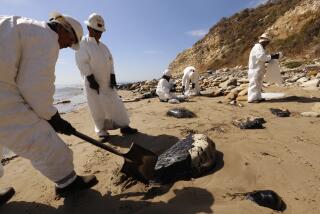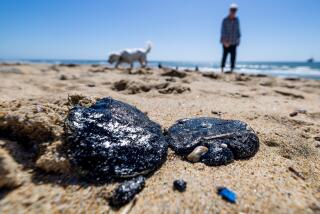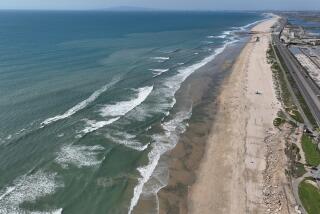Spill Damage Expected to Be Light : Environment: Officials are optimistic that offshore accident will not be a major threat to wildlife and beaches. High winds dissipate slick of oil mixture.
- Share via
Oil from a weekend pipeline spill in Santa Monica Bay washed up along 3 1/2 miles of Malibu beaches Monday, permeating the well-heeled surfside community with the stench of petroleum.
“You can smell it before you see it,” said California Coastal Commissioner Madelyn Glickfeld, a Malibu resident. “The smell is absolutely overpowering.”
Cleanup efforts were halted late Monday afternoon as winds of up to 25 knots made it unsafe for small boats to remain at sea. Officials also said the wind and surf had dissipated the slick so that there was little that mechanical equipment could do.
An estimated 21,000 gallons of a light, diesel-like oil mixture spilled into Santa Monica Bay on Saturday night when a tanker punctured a pipeline while attempting to dock at Chevron, U.S.A.’s oil terminal off El Segundo.
“We are real optimistic that the impact of this spill on the natural resources will be pretty small,” said Lt. Reed Smith, Southern California oil spill coordinator for the state Department of Fish and Game.
About 18 oil-soaked birds, most of them Western grebes, were found, 10 of them dead. Among the oiled birds found alive were two loons.
By Monday afternoon, damage to the beaches was “slight,” said U.S. Coast Guard spokesman Capt. James B. Morris. He said he anticipated that winds from a storm Monday night would “push the oil to the east and toward Santa Monica Bay.”
Throughout the day, about 300 workers clad in yellow rain slickers and knee-high rubber boats stood in Malibu’s waters and tried to soak up oil from the foam with absorbent materials. Many of the workers also prepared the beaches for the possible arrival of more oil, raking up kelp and other material that could get in the way of the cleanup.
Malibu residents complained repeatedly that a foul odor made them nauseated and gave them headaches. A Coast Guard spokesman acknowledged that the fumes could cause respiratory distress but said the symptoms would not persist or cause long-lasting problems.
State wildlife officials said they were concerned about a run of grunion, expected Monday night. Grunion come ashore to lay their eggs, of which 80% normally hatch, said Smith of the Fish and Game Department. He feared the oil could send that rate crashing to 15%.
Smith noted that grunion “scouts” are known to come ashore first and head off the rest of the fish if there is too much light or activity on the beach.
Fish and Game spokesman Curt Taucher noted that during last year’s oil spill off Huntington Beach, thousands of grunion “came right up through the oil, spawned and swam back out to sea.”
Investigators said they are continuing to probe the cause of the accident and will review docking procedures to help improve safety.
Patches of a rainbow sheen of oil covered an area more than six miles long and two miles wide Monday morning, from Malibu toward the east. By afternoon, only small blotches of sheen remained, most of it less than a mile offshore, said Coast Guard marine science technician Shawn Lootens.
Protective booms were stretched across the mouths of Malibu and Ballona creeks, sensitive wetlands areas. Marina del Rey Harbor, which was closed Saturday night, reopened Monday afternoon.
Morris said patches of oil called “pancakes,” measuring between one-quarter inch to 1 1/2 inches in diameter, had washed ashore. Most residents in Malibu saw only a brown-tinged foam in the water and, in the early morning hours, a rainbow sheen over the sand.
“I’ve just come from visiting people at Las Tunas Beach (about five miles from Malibu Pier), where you can smell the spill,” Glickfeld said.
Officials said the consistency of the oil mixture was both a blessing and a hindrance to the cleanup. Corralling the light mixture with booms poses problems, but the oil evaporates more quickly than crude.
Officials said the cleanup has gone remarkably well, primarily because the spill was relatively small. It paled in comparison to last year’s American Trader accident, in which the vessel gouged itself with its anchor off Huntington Beach and spewed 390,000 gallons of Alaska crude onto 15 miles of Orange County beaches.
In Saturday’s accident, the anchor of the 616-foot tanker OMI Dynachem gashed a 26-inch pipeline belonging to Chevron. The pipeline, which was not in service, was believed to hold 7,320 barrels of the oily mixture.
Coast Guard officials said Chevron pumped out about 6,600 barrels from the broken pipe and could not account for about 500 barrels, or 21,000 gallons.
Oil stopped seeping from the pipeline early Sunday afternoon, officials said. One section of the broken line had been found and sealed, but divers were searching for the other section Monday.
Lootens of the Coast Guard said results of urine tests given to the ship’s officers and the mooring master were not available Monday, but Breathalyzer tests indicated no alcohol use.
Coast Guard officials said buoys are supposed to alert vessels to the locations of underwater pipelines but noted that investigators will be looking at docking procedures to determine if greater safety can be ensured.
A consortium of environmental groups Monday called for an immediate moratorium on oil tanker loading off Southern California beaches until oil companies can prove their offshore terminals are safe.
“This is the second time in 13 months that offshore oil unloading has resulted in an oil spill,” said Cliff Gladstein, president of Santa Monica-based Heal the Bay. “In both cases, it appears that human error, faulty knowledge of sea bottoms and an inability to use ship anchors properly resulted in an environmental accident.”
Environmentalists also complained that public health officials should have posted signs alerting swimmers and surfers to stay out of the polluted waters.
Coast Guard officials and California Department of Resources director Douglas Wheeler said swimming restrictions are unnecessary because there is too little oil to cause health problems.
Elected officials said there is little chance that the spill will lead to the banning of the procedure that caused it--the docking of an oil tanker on an offshore terminal. Those who oppose offshore drilling said it is difficult to simultaneously oppose offshore docking, which has been considered environmentally safer than offshore drilling and in theory lessens the pressure for drilling.
Contributing to this story were Times political writer Cathleen Decker and staff writers Ron Russell and Faye Fiore.
GRADATIONS OF OIL IN SPILLS
A crude oil spill is the most difficult to clean up because crude is the heaviest oil, takes the longest to evaporate and clings the most to wildlife. When the lighter, refined oil is spilled, generally the evaporation process is quicker and cleanup is easier. Cleaning up any kind of oil spill depends on the temperature of the water and weather conditions.
Here are the four kinds of oil most often involved in spills:
* Unrefined basic crude, the oil straight from the ground. The most difficult to clean up, this was the oil involved in the 1989 Exxon Valdez spill.
* Industrial fuel, sometimes called bunker fuel. The heaviest of the oils that are refined, it is used to power such things as electrical generation plants and oceangoing vessels.
* Distillates such as jet fuel, diesel fuel, home heating oil and kerosene. They tend to evaporate more easily than crude or industrial.
* Gasoline, the lightest product refined from crude oil. It is generally easiest to clean up and quickest to evaporate.
Source: American Petroleum Institute Compiled by researcher Tracy Thomas
THE OIL SPILL
Oil from an undersea pipeline punctured by a ship anchor started washing up on beaches at Topanga and Malibu Monday. An estimated 21,000 gallons of diesel oil and jet fuel leaked from the Chevron pipeline, creating an almost transparent slick 6.5 miles long and 2.5 miles wide. The accident occurred 13 months after 400,000 gallons of crude spilled off Huntington Beach from a tanker gashed by its own anchor.
Pipeline: Puncture in the 26-inch pipeline was 60 feet under water, one mile off the Chevron refinery in El Segundo.
Tanker: The 616-foot tanker OMI Dynachem was backing into a berth at a mooring off shore when its crew decided to abort the docking. The anchor struck and pierced the pipeline. The ship, carrying solvent used in gasoline, was not damaged.
Crew: Breathalyzer tests of the ship’s officers and mooring master indicated no alcohol use.
COMPARING SPILLS
GALLONS SPILLED SIZE Santa Monica 21,000 (est.) 6.5 miles long, 2 miles wide March 16, 1991 (as of Monday morning) Huntington Beach over 390,000 12 miles long, 3.5 miles wide Feb. 7, 1990 Valdez, Alaska 11 million covered 100 square miles March 24, 1989 Saudi Arabia 63 to 84 million 10 to 15 miles along Saudi coast Jan. 19, 1991
Source: Los Angeles Times news file
More to Read
Sign up for Essential California
The most important California stories and recommendations in your inbox every morning.
You may occasionally receive promotional content from the Los Angeles Times.












